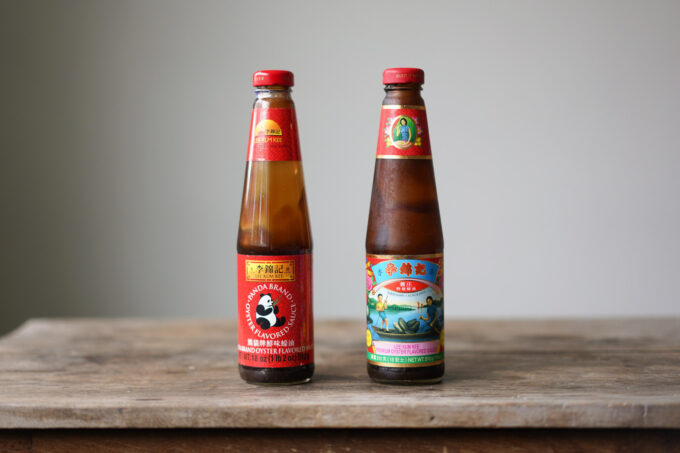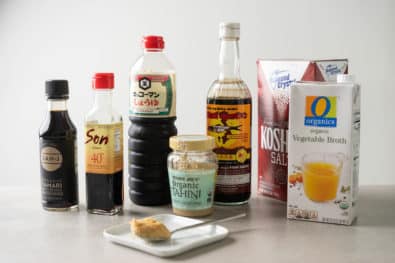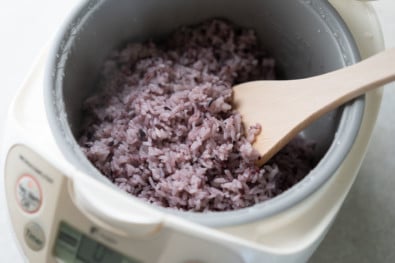
What is oyster sauce?
My very first introduction to oyster sauce was Chinese Broccoli at a dim sum restaurant. Oyster sauce coats these substantial stems like a shimmery viscous blanket, balancing its steamy neutralness with a blend of umami and sweet. Not only is it the cosmically perfect accompaniment to Kai-lan (aka Chinese Broccoli), oyster sauce is often used for marinating, cooking and stir-frying. Some common dishes that feature oyster sauce:
- Steamed Pork Banh Bao – China, Vietnam
- Gailan Chinese Broccoli – China, Vietnam
- Crab in oyster sauce – China, Singapore, Indonesia, Philippines
- Buddha’s delight – China, Buddhists
- Hainanese chicken rice – Immigrant dish Southern China Hainan Province, Singapore, Malaysia
- Cashew chicken – Chinese American
- Lo mein – China, Chinese American
- Bò lúc lắc – Vietnam, Vietnamese American
- Garlic noodles – China
- Wonton soup – China
Oyster sauce was discovered by accident by Lee Kum Sheung in Guangdong Province 1888. In his tea and oyster soup stall, he accidentally overcooked a batch of oyster broth which transformed into a magical brown sauce with deep flavor. Realizing its potential as a condiment, he started selling it to locals and thus the famed Lee Kum Kee company was born. (If you’re wondering, the word “Kee” is like a brand prefix in Cantonese.)
Originating in southern China, oyster sauce was used in Cantonese cooking but soon spread to Thai, Vietnamese, and Khmer cuisine. Today, oyster sauce is a staple of Chinese home cooking. Americans may have inadvertently eaten oyster sauce in common Chinese American dishes such as beef and broccoli or chow mein. Its use is internationally widespread as these dishes have proliferated.
What is oyster sauce made of?
Oyster sauce is typically made with oysters, water salt, sugar, MSG, modified corn starch, wheat flour, and caramel color.
The vegetarian versions of it are usually made of the same ingredients but instead of oysters, there’s soybeans, brown sugar, and mushroom flavor.
Are there oysters in it?
It is not just a name, folks! There are oysters in oyster sauce. However, most mass-produced brands use oyster extract in combination with the bulk of sugar and cornstarch in place of the traditional and apparently cost-prohibitive process of caramelizing oyster broth. “True” oyster sauce is not supposed to contain any salt or added flavors! Even with the concentration of oysters in question, there undoubtedly remains some remnant of actual oysters to give the sauce its signature funk.
The general rule for oyster sauce (and most processed foods for that matter): The lower the quality, the less flavorful the sauce, thereby a heavier reliance on taste enhancers such as MSG and soy sauce.
The one unintended benefit? Vegetarian substitutes (like Vegetarian Mushroom Flavored Stir-Fry Sauce) that displace pricey oysters are typically lower in price.
What does it taste like?
The flavor, color and texture of oyster sauce is expectedly divergent from its original fresh and briny origin. It’s is a wonder of sweet, savory, and umami. True to its name, oyster sauce features a slight fishy, ocean quality, reportedly more pronounced in its Thai iterations. Originally created by caramelizing oyster broth, today’s quicker mass-produced version attempts to mimic that slowly-reduced, concentrated umami flavor with oyster extract.
With its salty sweet quality, it changes and enhances the flavor of meat in a way similar to using other salt sources like soy and fish sauce. For added variety and rich umami, give oyster sauce a try. Over a thousand years spreading globally and spawning an entire sauce empire, oyster sauce can’t be wrong!
Vegetarian oyster sauce options
For vegetarians or those who suffer from shellfish allergies, there are many substitutes available for oyster sauce. In order to achieve its rich depth of umami, mushrooms are often used in place of the offending shellfish. From store-bought to DIY, there are many ways to cook dishes containing oyster sauce by using none at all!
Here are the top picks for oyster sauce substitutes:
- Lee Kum Kee – Vegetarian Mushroom Flavored Stir-Fry Sauce
- Kimlan – Vegetarian Mushroom Oyster Sauce
- Wa Jan Shan – Vegetarian Mushroom Oyster Sauce
Oyster sauce substitutions in a pinch
If you’re already half-way through a recipe and realize you are fresh out, fear not! Here are some ways you can replace oyster sauce with other common ingredients:
- Mix soy sauce and hoisin sauce together in a 1:1 ratio
- Simply use soy sauce which roughly matches color, intensity and flavor. To kick it up a few notches, try adding a few drops of Worcestershire sauce and, or a bit of sugar (Note: Worcestershire sauce contains anchovies but there are vegan versions available too)
- Bean sauce, a fermented bean sauce of Sichuan and Cantonese origin
- As a last resort due to different consistency, try a bit of fish sauce as a replacement
Making your own oyster sauce
For the ambitious homecooks out there, Omnivore’s Cookbook has an innovative vegan recipe using a base of dried shiitake mushrooms.
Instead of oyster broth, mushrooms cook down into a veritable umami-bomb free of the usual additives and flavor enhancers.
In place of modified starch, glucose syrup, MSG and preservatives, this recipe utilizes ginger, garlic, miso paste and five-spice to enhance flavor naturally.
What are the best oyster sauce brands?
Cook’s Illustrated chooses Lee Kum Kee Premium Oyster Sauce as their prefered brand.
You’ll find a varied patch of answers throughout the internet, but the reigning answer seems to be Lee Kum Kee brand in particular and its flagship Premium Oyster Sauce.
Amazon reviewers claim that quality is higher and that it uses actual oysters but that it still contains MSG. Given that Lee Kum Kee is literally the longest-standing oyster sauce brand, it’s no surprise that people have a strong sense of brand loyalty. Even I grew up with this brand in our cupboard.
Singaporean and former resident of Asia, Europe and US Jirah Tan recommends using Thai oyster sauce for Thai dishes and Chinese sauce for Chinese cooking. She contends that Thai oyster sauces are saltier and the “tang of the sea is more pronounced”. She recommends Thai brand Maekura.
We have yet to find an artisanal brand out there that uses the painstaking original process of caramelizing oyster broth. Perhaps there is no demand because most people have probably never tasted the real thing. For the adventurous, this home recipe makes the attempt, though its ingredients seem to conflict with the aforementioned “true oyster sauce” formulation that forbids additives.
How to use oyster sauce
Oyster sauce has many uses as a sauce to top foods, coat and marinate meats and vegetables. Here are some tips for using oyster sauce:
- Overcooking oyster sauce will result in the loss of its umami flavor. Add it towards the end of braising meat or cooking soup.
- Avoid using high heat as it will transform its umami into bitterness
- Marinating meat and fish with oyster sauce will help neutralize off-putting smells
- Reduce or replace salt entirely with oyster sauce, which itself has high salt content
Oyster sauce vs. hoisin sauce
People like to compare oyster sauce with hoisin sauce for their apparent similarities. They are both brown, thick, and sweet. They haven’t crossed paths in my personal experience because I find that both have very specific uses in their respective cuisines. However, they are close enough to act as substitutes for each other (see above).
The core of Hoisin sauce is toasted, mashed soy beans with fennel seeds, red chillies, and garlic. While “hoisin” means seafood in Chinese, it does not contain any. Oyster sauce does.









